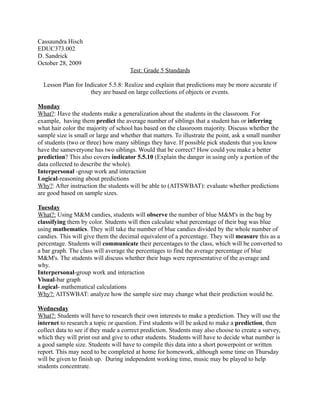
Weekly Lesson Plan Example
- 1. Cassaundra Hisch EDUC373.002 D. Sandrick October 28, 2009 Test: Grade 5 Standards Lesson Plan for Indicator 5.5.8: Realize and explain that predictions may be more accurate if they are based on large collections of objects or events. Monday What?: Have the students make a generalization about the students in the classroom. For example, having them predict the average number of siblings that a student has or inferring what hair color the majority of school has based on the classroom majority. Discuss whether the sample size is small or large and whether that matters. To illustrate the point, ask a small number of students (two or three) how many siblings they have. If possible pick students that you know have the sameveryone has two siblings. Would that be correct? How could you make a better prediction? This also covers indicator 5.5.10 (Explain the danger in using only a portion of the data collected to describe the whole). Interpersonal -group work and interaction Logical-reasoning about predictions Why?: After instruction the students will be able to (AITSWBAT): evaluate whether predictions are good based on sample sizes. Tuesday What?: Using M&M candies, students will observe the number of blue M&M's in the bag by classifying them by color. Students will then calculate what percentage of their bag was blue using mathematics. They will take the number of blue candies divided by the whole number of candies. This will give them the decimal equivalent of a percentage. They will measure this as a percentage. Students will communicate their percentages to the class, which will be converted to a bar graph. The class will average the percentages to find the average percentage of blue M&M's. The students will discuss whether their bags were representative of the average and why. Interpersonal-group work and interaction Visual-bar graph Logical- mathematical calculations Why?: AITSWBAT: analyze how the sample size may change what their prediction would be. Wednesday What?: Students will have to research their own interests to make a prediction. They will use the internet to research a topic or question. First students will be asked to make a prediction, then collect data to see if they made a correct prediction. Students may also choose to create a survey, which they will print out and give to other students. Students will have to decide what number is a good sample size. Students will have to compile this data into a short powerpoint or written report. This may need to be completed at home for homework, although some time on Thursday will be given to finish up. During independent working time, music may be played to help students concentrate.
- 2. Intrapersonal- students decide on a topic of interest to themselves and are given time for independent work Musical-music can be played while students work independently, which can help some concentrate better. Why?: AITSWBAT demonstrate that they know that sample size influences whether predictions are correct. Thursday What?: Students will continue to work on the powerpoints or reports to make any finishing touches. All powerpoints and reports will be submitted to the teacher. Some students will have the opportunity to communicate their findings with the class. Linguistic-sharing their findings with the class and turning in written reports Interpersonal- Sharing with the class Why?: AITSWBAT share their predictions and whether or not they were correct as evidenced by the completed powerpoint presentation or written report. The reports will be assessed for completeness and understanding of the concept. Friday What?: (Friday's activity may be moved to Wednesday and the powerpoints would be moved to Thursday and Friday, if the weather requires it.) We will further explore the fact that predictions will be more accurate if they are based on large samples by predicting and collecting data on the percentage of four leaf clovers. Beforehand, the teacher should mark off sections of grass for students to search for four leaf clovers. Before going out, students should make a prediction. The predictions should be made based on how many four leaf clovers are present in one square foot of grass. Hopefully there is sufficient grassy areas around the playground. Students should work in groups and comb through their square foot area of grass for four leaf clovers. Students should record their data as they find them. After a set time, or after they have thoroughly checked their areas, students should regroup and compile a list of how many they found and how many total square feet were covered. Once again, they will be able to see that by having a larger collection of data, they can have a better prediction. After this, the students will be asked to write a journal entry (language arts) discussing how making predictions based on small collections is similar to stereotyping a gender or race based on the behaviors of a few people. This will be collected on Monday. Kinesthetics- students are able to get out of the classroom and move around outside Natural- students are outside in nature Interpersonal-students are working together Why?: AITSWBAT explain how predictions are affected by collection size as. Students' journal entries will be assessed to check for understanding of the danger of judging something based on incomplete evidence or data.
